key PORSCHE CAYNNE 2008 1.G Information Manual
[x] Cancel search | Manufacturer: PORSCHE, Model Year: 2008, Model line: CAYENNE, Model: PORSCHE CAYENNE 2008 1.GPages: 95, PDF Size: 3.37 MB
Page 23 of 95
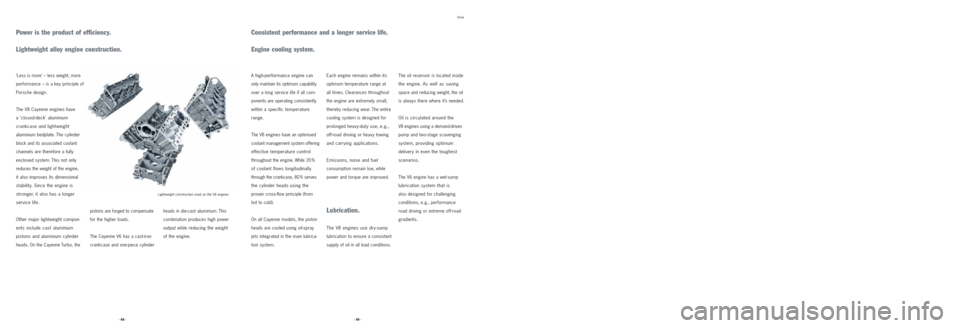
Power is the product of efficiency.
Lightweight alloy engine construction.
‘Less is more’ – less weight, more
performance – is a key principle of
Porsche design.
The V8 Cayenne engines have
a ‘closed-deck’ aluminium
crankcase and lightweight
aluminium bedplate. The cylinder
block and its associated coolant
channels are therefore a fully
enclosed system. This not only
reduces the weight of the engine,
it also improves its dimensional
stability. Since the engine is
stronger, it also has a longer
service life.
Other major lightweight compon-
ents include cast aluminium
pistons and aluminium cylinder
heads. On the Cayenne Turbo, the
pistons are forged to compensate
for the higher loads.
The Cayenne V6 has a cast-iron
crankcase and one-piece cylinderheads in die-cast aluminium. This
combination produces high power
output while reducing the weight
of the engine.
Drive
Lightweight construction used on the V8 engines
Consistent performance and a longer service life.
Engine cooling system.
Each engine remains within its
optimum temperature range at
all times. Clearances throughout
the engine are extremely small,
thereby reducing wear. The entire
cooling system is designed for
prolonged
heavy-duty use, e.g.,
off-road driving or heavy towing
and carrying applications.
Emissions, noise and fuel
consumption remain low, while
power and torque are improved.
Lubrication.
The V8 engines use dry-sump
lubrication to ensure a consistent
supply of oil in all load conditions.
The oil reservoir is located inside
the engine. As well as saving
space and reducing weight, the oil
is always there where it’s needed.
Oil is circulated around the
V8 engines using a demand-driven
pump and two-stage scavenging
system, providing optimum
delivery in even the toughest
scenarios.
The V6 engine has a wet-sump
lubrication system that is
also designed for challenging
conditions, e.g., performance
road driving or extreme off-road
gradients.
A high-performance engine can
only maintain its optimum capability
over a long service life if all com-
ponents are operating consistently
within a specific temperature
range.
The V8 engines have an optimised
coolant management system offering
effective temperature control
throughout the engine. While 20 %
of coolant flows longitudinally
through the crankcase, 80 % serves
the cylinder heads using the
proven cross-flow principle (from
hot to cold).
On all Cayenne models, the piston
heads are cooled using oil-spray
jets integrated in the main lubrica-
tion system.
· 49 · · 48 ·
Page 26 of 95

There is one fuel that will always be free.
Which is why we make the most of it.
Air intake system.
The Cayenne models are all
equipped with a resonance air
intake system. This simple
technology uses the pressure
waves generated by the inlet
valves to ‘force’ air into the engine.
The effect is enhanced in
the Cayenne, Cayenne S and
Cayenne GTS by a two-stage
intake manifold. This combines all
the benefits of a long intake tube
(higher torque at low rpm) with
those of a shorter length (more
power at higher rpm). On theCayenne GTS, performance is
enhanced by optimised airflow
management in the intake manifold.
Although ‘naturally aspirated’,
the Cayenne, Cayenne S and
Cayenne GTS provide high torque
ratings across the entire engine
speed range.
Drive
Pressure is often the key to performance.
Turbocharging system in the Cayenne Turbo.
The Porsche Turbo is synonymous
with performance, exhilarating
acoustics and the finest engineering.
The Cayenne Turbo has twin
turbocharger units arranged in
parallel. The low-volume intake
pipes combine with short exhaust
manifolds to achieve a rapid,
emphatic response.
Incoming air is passed through a
filter and compressed by the turbine
units. Its temperature is then
reduced in the intercooler system,
which improves cylinder charging
and limits thermal loads on the
engine.
Boost pressure reaches 1.8 bar
(absolute pressure) under full
acceleration from just 2,500 rpm.In normal road driving (part-throttle
mode), the pre-throttle boost
pressure is reduced in order
to
maximise fuel economy. When
the car is driven more assertively,
the
turbines are ‘pre-spun’ so
as to increase the pressure
available. When the throttle is
finally opened, the boost can
be applied immediately.
Both turbo units are cooled by
dedicated circuits from the main
engine cooling system.This solutionprevents oil degradation due to
overheating.
For the driver, the result is
seamless delivery of phenomenal
power and torque.
· 55 · · 54 ·
Page 27 of 95

· 58 · · 57 · · 56 ·
Used to regulate /control Input data Used to regulate /control
Engine management system
(MED 9.1)
Engine load
Throttle-valve angle
Oxygen sensor signals
Engine speed (from crankshaft)
Inlet camshaft phase angle
Knock sensor signals
Vehicle speed
Air-conditioning settings
Throttle pedal position
Temperatures
– Coolant
– Intake air
– Engine oil
– Ambient air
Zündung
Direct fuel injection (DFI)
Idling via throttle valve and ignition
Heating elements in oxygen sensors
Demand-controlled fuel pump
Fuel-tank venting
CAN interface to PSM control unit, transmission control unit, engine immobiliser, instrument cluster,
air-conditioning control unit, ‘Sport’ button, on-board diagnostics, etc.
Input data
Camshaft phase angle
Engine fan
Starter
Fuel pressure
Throttle valve
Intake manifold resonance valve
Engine management functions in the Cayenne S, Cayenne GTS and Cayenne Turbo. Engine management functions in the Cayenne.
Drive
Maximum freedom requires total control.
Electronic engine management.
The electronic engine management
system provides coordinated
regulation of all engine functions
and associated systems in all
operating conditions.
The basic principle of engine
management is simple. Throughout
each journey, the system monitors
a range of input data and compares
it with corresponding sets of
reference values (‘maps’). Key
engine functions, such as ignition
and fuel injection, can be seamlessly
and automatically adjusted. The
results: optimum fuel economy and
lower emissions as well as greater
power and torque.One of the most important systems
controlled by engine management
is the electronic throttle, a
prerequisitefor Porsche Stability
Management
(PSM). Other major
functions include on-board diagnos-
tics and cylinder-specific knock
control featuring automatic compen-
sation for changes in fuel quality.
On the Cayenne, Cayenne S
and Cayenne GTS, the engine
management system controls
the variable-tract intake manifold.
On the Cayenne Turbo, it regulates
the turbo boost pressure.
Fuel pressure
Oil pressure
Engine management system
(EMS SDI 4.1)
Throttle-valve angle
Oxygen sensor signals
Engine speed (from crankshaft)
Inlet camshaft phase angle
Knock sensor signals
Vehicle speed
Air-conditioning settings
Throttle pedal position
Temperatures
– Coolant
– Intake air
– Engine oil
– Ambient air
Ignition
Direct fuel injection (DFI)
Idling via throttle valve and ignition
Heating elements in oxygen sensors
Demand-controlled fuel pump
Fuel-tank venting
CAN interface to PSM control unit, transmission control unit, engine immobiliser, instrument cluster,
air-conditioning control unit, ‘Sport’ button, on-board diagnostics, etc.
Valve lift (VarioCam Plus)
Engine fan
Starter
Fuel pressure
Throttle valve
Intake manifold resonance valve
(Cayenne S/Cayenne GTS)
Fuel pressure
Oil pressure
Wastegate frequency valve
(Cayenne Turbo only)
Bypass valves (Cayenne Turbo only)
Camshaft phase angle
Oil pressure
Engine load
Ignition
Cylinder-specific knock control
Cylinder-specific knock control
Page 34 of 95
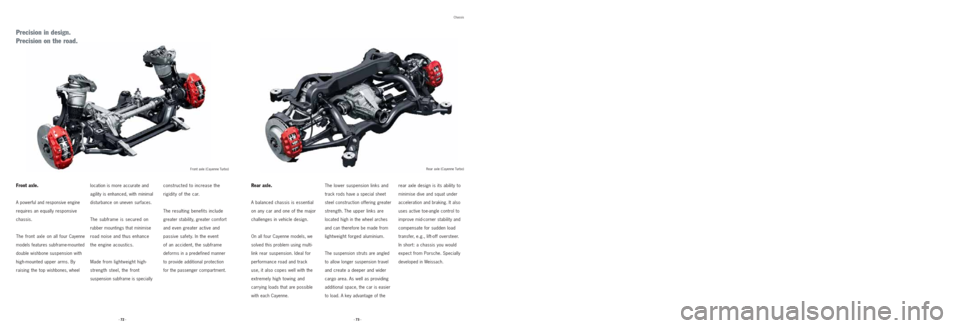
Chassis
Precision in design.
Precision on the road.
location is more accurate and
agility is enhanced, with minimal
disturbance on uneven surfaces.
The subframe is secured on
rubber mountings that minimise
road noise and thus enhance
the engine acoustics.
Made from lightweight high-
strength steel, the front
suspension subframe is specially
constructed to increase the
rigidity of the car.
The resulting benefits include
greater stability, greater comfort
and even greater active and
passive safety. In the event
of an accident, the subframe
deforms in a predefined manner
to provide additional protection
for the passenger compartment.
Front axle.
A powerful and responsive engine
requires an equally responsive
chassis.
The front axle on all fourCayenne
models features subframe-mounted
double wishbone
suspension with
high-mounted upper arms. By
raising the top
wishbones, wheel
Rear axle.
A balanced chassis is essential
on any car and one of the major
challenges in vehicle design.
On all four Cayenne models, we
solved this problem using multi-
link rear suspension. Ideal for
performance road and track
use, it also copes well with the
extremely high towing and
carrying loads that are possible
with each Cayenne.
The lower suspension links and
track rods have a special sheet
steel construction offering greater
strength. The upper links are
located high in the wheel arches
and can therefore be made from
lightweight forged aluminium.
The suspension struts are angled
to allow longer suspension travel
and create a deeper and wider
cargo area. As well as providing
additional space, the car is easier
to load. A key advantage of the
rear axle design is its ability to
minimise dive and squat under
acceleration and braking. It also
uses active toe-angle control to
improve mid-corner stability and
compensate for sudden load
transfer, e.g., lift-off oversteer.
In short: a chassis you would
expect from Porsche. Specially
developed in Weissach.
Front axle (Cayenne Turbo) Rear axle (Cayenne Turbo)
· 73 · · 72 ·
Page 38 of 95
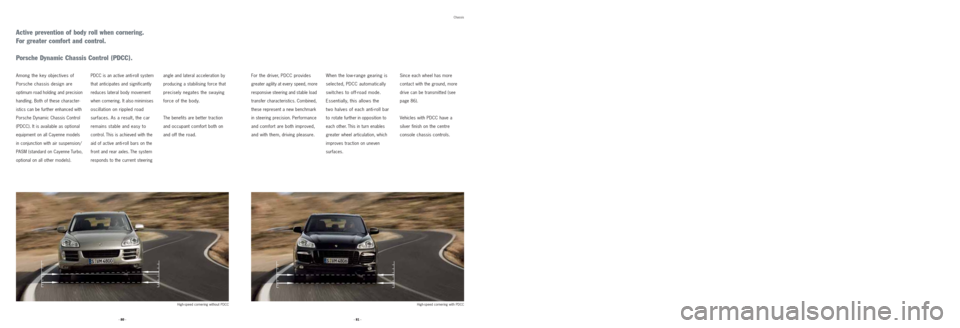
Chassis
Active prevention of body roll when cornering.
For greater comfort and control.
Porsche Dynamic Chassis Control (PDCC).
PDCC is an active anti-roll system
that anticipates and significantly
reduces lateral body movement
when cornering. It also minimises
oscillation on rippled road
surfaces. As a result, the car
remains stable and easy to
control. This is achieved with the
aid of active anti-roll bars on the
front and rear axles. The system
responds to the current steeringangle and lateral acceleration by
producing a stabilising force that
precisely negates the swaying
force of the body.
The benefits are better traction
and occupant comfort both on
and off the road.For the driver, PDCC provides
greater agility at every speed, more
responsive steering and stable load
transfer characteristics. Combined,
these represent a new benchmark
in steering precision. Performance
and comfort are both improved,
and with them, driving pleasure.
When the low-range gearing is
selected, PDCC automatically
switches to off-road mode.
Essentially, this allows the
two halves of each anti-roll bar
to
rotate further in opposition to
each other. This in turn enables
greater wheel articulation, which
improves traction on uneven
surfaces.Since each wheel has more
contact with the ground, more
drive can be transmitted (see
page 86).Vehicles with PDCC have a
silver finish on the centre
console chassis controls. Among the key objectives of
Porsche chassis design are
optimum road holding and precision
handling. Both of these character-
istics can be further enhanced with
Porsche Dynamic Chassis Control
(PDCC). It is available as optional
equipment on all Cayenne models
in conjunction with air suspension/
PASM (standard on Cayenne Turbo,
optional on all other models).
High-speed cornering without PDCC High-speed cornering with PDCC
· 81 · · 80 ·
Page 46 of 95
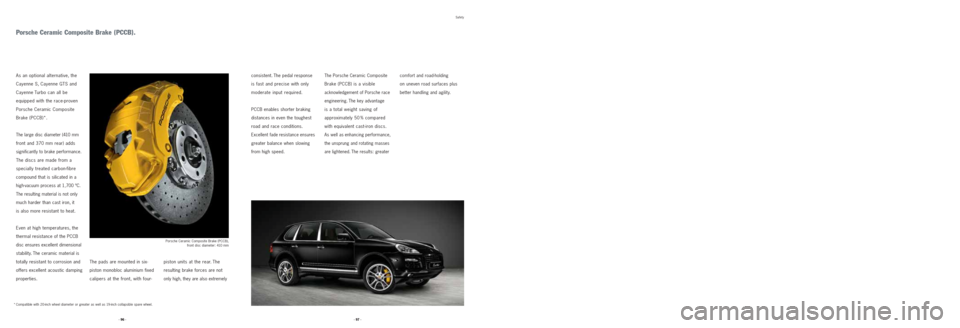
piston units at the rear. The
resulting brake forces are not
only high, they are also extremely
Porsche Ceramic Composite Brake (PCCB).
Porsche Ceramic Composite Brake (PCCB),
front disc diameter: 410 mm
The pads are mounted in six-
piston monobloc aluminium fixed
calipers at the front, with four-
Safety
As an optional alternative, the
Cayenne S, Cayenne GTS and
Cayenne Turbo can all be
equipped with the race-proven
Porsche Ceramic Composite
Brake (PCCB)*.
The large disc diameter (410 mm
front and 370 mm rear) adds
significantly to brake performance.
The discs are made from a
specially treated carbon-fibre
compound that is silicated in a
high-vacuum process at 1,700 ºC.
The resulting material is not only
much harder than cast iron, it
is also more resistant to heat.
Even at high temperatures, the
thermal resistance of the PCCB
disc ensures excellent dimensional
stability. The ceramic material is
totally resistant to corrosion and
offers excellent acoustic damping
properties.consistent. The pedal response
is fast and precise with only
moderate input required.
PCCB enables shorter braking
distances in even the toughest
road and race conditions.
Excellent fade resistance ensures
greater balance when slowing
from high speed.
· 97 · · 96 ·
The Porsche Ceramic Composite
Brake (PCCB) is a visible
acknowledgement of Porsche race
engineering. The key advantage
is a total weight saving of
approximately 50 % compared
with equivalent cast-iron discs.
As well as enhancing performance,
the unsprung and rotating masses
are lightened. The results: greater
comfort and road-holding
on uneven road surfaces plus
better handling and agility.
* Compatible with 20-inch wheel diameter or greater as well as 19-inch collapsible spare wheel.
Page 48 of 95
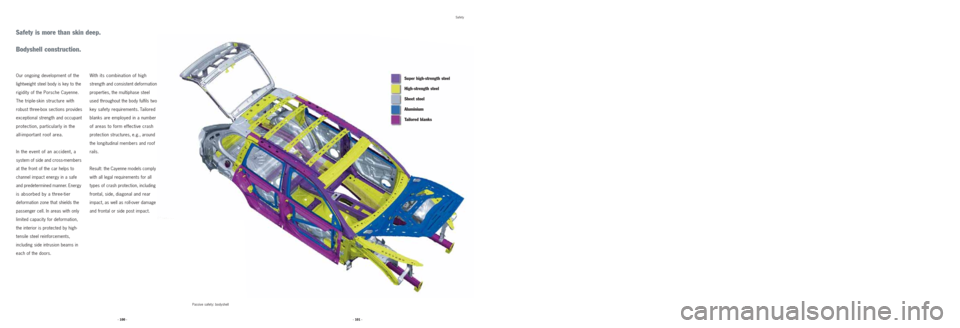
Our ongoing development of the
lightweight steel body is key to the
rigidity of the Porsche Cayenne.
The triple-skin structure with
robust three-box sections provides
exceptional strength and occupant
protection, particularly in the
all-important roof area.
In the event of an accident, a
system of side and cross-members
at the front of the car helps to
channel impact energy in a safe
and predetermined manner. Energy
is absorbed by a three-tier
deformation zone that shields the
passenger
cell. In areas with only
limited capacity for deformation,
the interior is protected by high-
tensile steel reinforcements,
including side intrusion beams in
each of the doors.
Safety is more than skin deep.
Bodyshell construction.
Safety
With its combination of high
strength and consistent deformation
properties, the multiphase steel
used throughout the body fulfils two
key safety requirements. Tailored
blanks are employed in a number
of areas to form effective crash
protection structures, e.g., around
the longitudinal members and roof
rails.
Result: the Cayenne models comply
with all legal requirements for all
types of crash protection, including
frontal, side, diagonal and rear
impact, as well as roll-over damage
and frontal or side post impact.Super high-strength steel
High-strength steel
Sheet steel
Aluminium
Tailored blanks
· 101 · · 100 ·Passive safety: bodyshell
Page 49 of 95
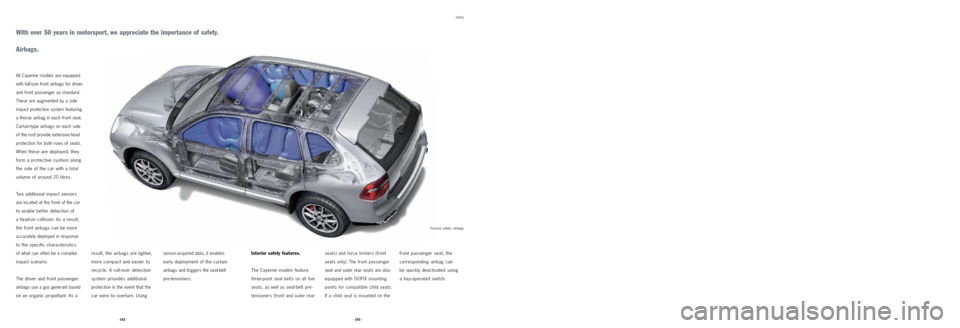
With over 50 years in motorsport, we appreciate the importance of safety.
Airbags.
All Cayenne models are equipped
with full-size front airbags for driver
and front passenger as standard.
These are augmented by a side-
impact protection system featuring
a thorax airbag in each front seat.
Curtain-type airbags on each side
of the roof provide extensive head
protection for both rows of seats.
When these are deployed, they
form a protective cushion along
the side of the car with a total
volume of around 20 litres.
Two additional impact sensors
are located at the front of the car
to enable better detection of
a head-on collision. As a result,
the front airbags can be more
accurately deployed in response
to the specific characteristics
of what can often be a complex
impact scenario.
The driver and front passenger
airbags use a gas generant based
on an organic propellant. As aresult, the airbags are lighter,
more compact and easier to
recycle. A roll-over detection
system provides additional
protection in the event that the
car were to overturn. Using
sensor-acquired data, it enables
early deployment of the curtain
airbags and triggers the seat-belt
pre-tensioners.
Interior safety features.
The Cayenne models feature
three-point seat belts on all five
seats, as well as seat-belt pre-
tensioners (front and outer rearseats) and force limiters (front
seats only). The front passengerseat and outer rear seats are also
equipped with ISOFIX mounting
points for compatible child seats.
If a child seat is mounted on the
front passenger seat, the
corresponding airbag can
be quickly deactivated using
a key-operated switch.
Safety
· 103 · · 102 ·Passive safety: airbags
Page 51 of 95
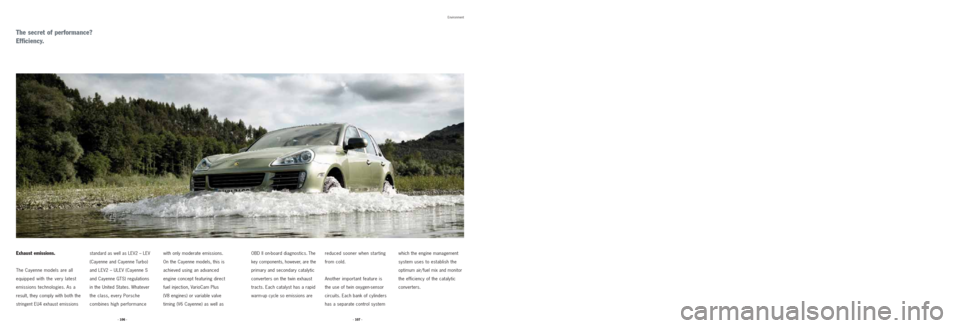
The secret of performance?
Efficiency.
OBD II on-board diagnostics. The
key components, however, are the
primary and secondary catalytic
converters on the twin exhaust
tracts. Each catalyst has a rapid
warm-up cycle so emissions are
which the engine management
system uses to establish the
optimum air/fuel mix and monitor
the efficiency of the catalytic
converters.
standard as well as LEV2 – LEV
(Cayenne and Cayenne Turbo)
and LEV2 – ULEV (Cayenne S
and Cayenne GTS) regulations
in the United States. Whatever
the class, every Porsche
combines high performance
Exhaust emissions.
The Cayenne models are all
equipped with the very latest
emissions technologies. As a
result, they comply with both the
stringent EU4 exhaust emissions
with only moderate emissions.
On the Cayenne models, this is
achieved using an advanced
engine concept featuring direct
fuel injection, VarioCam Plus
(V8 engines) or variable valve
timing (V6 Cayenne) as well asreduced sooner when starting
from cold.
Another important feature is
the use of twin oxygen-sensor
circuits. Each bank of cylinders
has a separate control system
Environment
· 107 · · 106 ·
Page 61 of 95

Comfort, ergonomics and security.
Anti-theft protection.
The Cayenne models are all
equipped as standard with an
engine immobiliser and anti-theft
alarm featuring ultrasonic interior
surveillance.
The alarm circuit includes all four
doors, engine lid, tailgate, rear
screen, interior, ignition and trailer
(if fitted).
The immobiliser system works by
automatically communicating with
the vehicle key. If the key is ap-
proved, the engine can be started
as normal.
When the key is removed from the
ignition, the steering column is
automatically locked to provide
additional security.
Porsche Entry & Drive.
With this optional system, you can
reduce the inconvenience of a con-
ventional key.
The moment you touch the door
handle
, the system automatically
checks the encrypted access code
on the key in your pocket. If the
code is accepted, the doors are
unlocked. To start or stop the
engine, simply push the ignition
button.
To lock the car on leaving, all you
have to do is press a button on the
outside of the door handle. Porsche
Entry & Drive then secures the car
doors, arms the immobiliser and
locks the steering column.
Preparation for vehicle
tracking system.
This optional preparation available
for all Cayenne models enables
future installation of a vehicle
tracking system obtainable from
Porsche Tequipment. The system
can be used to locate a stolen
vehicle across much of Europe.
Includes special wiring loom,
higher capacity battery (depend-
ing on vehicle specification) and
tilt sensor for the alarm system.
Cruise control.
Standard on the Cayenne Turbo
and optional on all other models,
cruise control offers increased
comfort on long-distance journeys.
It can be used at speeds between
30 and 240 km / h (19 and 149 mph)
and is activated using a button on
one of the control stalks.
Slide /tilt sunroof.
Available as an option on all
Cayenne models, the slide/tilt
sunroof is made from tinted
single-pane safety glass and has
a manually adjustable sunscreen.
The roof position is easily adjusted
using a single illuminated rotary
control. The sunroof also has
an anti-jam facility, as do all the
electric windows.
Comfort lighting package.
One of the special features in this
optional package is the ‘Welcome
Home’ lighting function. When you
arrive at a destination after dark,
the headlights remain
illuminated
Comfort
for a user-defined period, lighting
your path from the car. Other
features include courtesy lights
on both exterior
mirrors, auto-
matic headlight activation and
automatically dimming interior
and exterior mirrors.
· 127 · · 126 ·